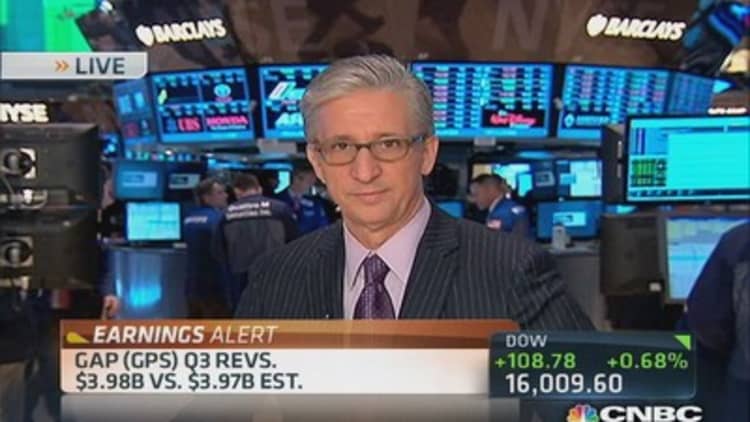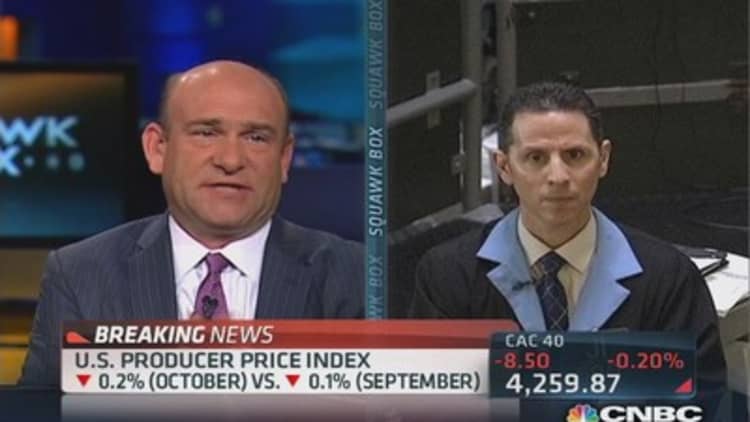
U.S. stocks climbed on Thursday, with the Dow Jones Industrial Average posting its first finish above 16,000, as the number of Americans filing for jobless benefits declined to a near two-month low.
"Jobless claims were better on the margins, inflation picked up a little, but no significant change there, and earnings and companies continue to do fairly well. And the market was drifting down, so it puts you a in a position where it doesn't take much good news to resume the rally," said Doug Foreman, co-chief investment officer at Kayne Anderson Rudnick.
Johnson Controls gained after the auto-parts manufacturer hiked its stock-buyback program by $3 billion; Target fell after the discount retailer reported a decline in earnings; Dollar Tree declined after the retailer's third-quarter profit missed expectations, and General Motors gained after the U.S. Treasury said it would sell its remaining stake in the auto maker.
Major U.S. Indexes
Making a triple-digit jump to close above 16,000 for the first time, the Dow Jones Industrial Average added 109.17 points, or 0.7 percent, to end at 16,009.99. It also turned positive for the week, with its gains led by Intel.
Halting its longest-running loss streak in eight weeks, the rose 14.48 points, or 0.8 percent, to 1,795.85, with financials leading gains and telecommunications the worst performing of its 10 major industry groups. The Nasdaq climbed 47.88 points, or 1.2 percent, to 3,969.15.
The CBOE Volatility Index (VIX), a measure of investor uncertainty which has advanced 3.9 percent this week, fell to 12.66.
For every share that fell, roughly three gained on the New York Stock Exchange, where nearly 669 million shares traded. Composite volume approached 3.3 billion.

The U.S. dollar fell against other global currencies, while the price of oil rose to a three-week high and the cost of gold declined.
After climbing to its highest since September, the yield on the benchmark 10-year 1 basis point 2.79 percent.
"Interest rates are fairly low by historical standards. Over time they are going to go up, especially if the economy really recovers. And ultimately that's a good thing," said Foreman of the instrument used in determining mortgage rates and other consumer loans.
On Wednesday, stocks fell and Treasury yields jumped after minutes from the Federal Reserve's last policy meeting had officials generally in agreement that improving economic conditions would pave the way to reduced asset purchases by the Fed in the months ahead.
And, while the jobs data came in better than expected on Thursday, "market participants are still reacting to the Fed minutes indicating that it's not just the jobs market that they are looking at, and they may reduce asset purchases sooner than expected," said Kate Warne, investment strategist at Edward Jones. "Clearly with the rebound we're seeing, the market is not expecting December," added Warne of the likely month that the central bank will start reducing the scope of its $85 billion in monthly purchases of bonds and mortgaged-backed securities.
In answering questions following a speech Thursday in Asheboro, N.C., Richmond Fed President Jeffrey Lacker said January through March would be a reasonable period to begin tapering. Lacker, an opponent of quantitative easing, also reiterated his stance that the Fed should have starting the process a while ago. Read prepared speech.
"Now that the earlier Californian computer glitches and government-shutdown related factors are moving along investors are starting to get a clearer view on the encouraging influences behind the labor market," Andrew Wilkinson, chief economic strategist at Miller Tabak, wrote in emailed commentary following weekly data, which had initial jobless claims falling by 21,000 to 323,000 from an upwardly revised 344,000 reading.
Economists had expected initial claims at 335,000.
A separate report had producer prices falling 0.2 percent in October, matching estimates.
A reading of manufacturing activity illustrated a slowdown in the Philadelphia region, with a from the month before, still positive "but stuck in lower gear," said Andrew Wilkinson, chief economic strategist at Miller Tabak.
—By CNBC's Kate Gibson
Coming Up This Week:
Thursday: Earnings after the close are expected from Autodesk, Gap, Intuit and Ross Stores.
More from CNBC:


